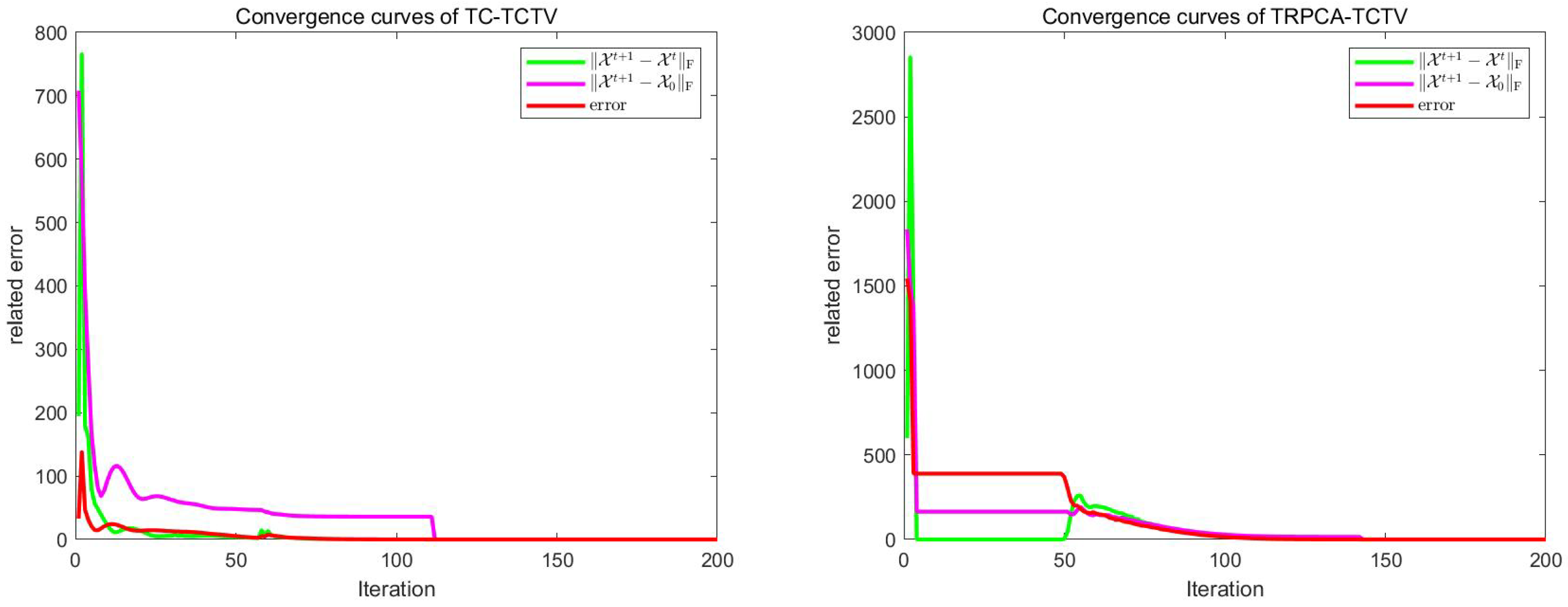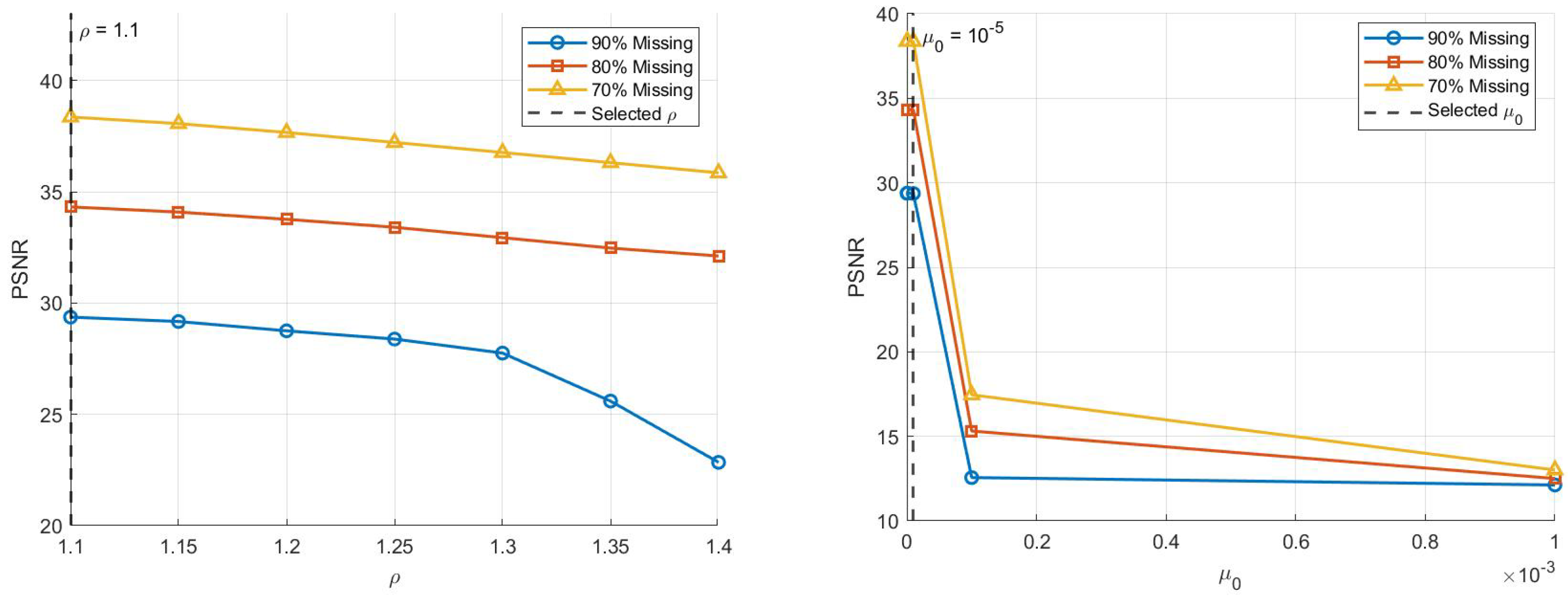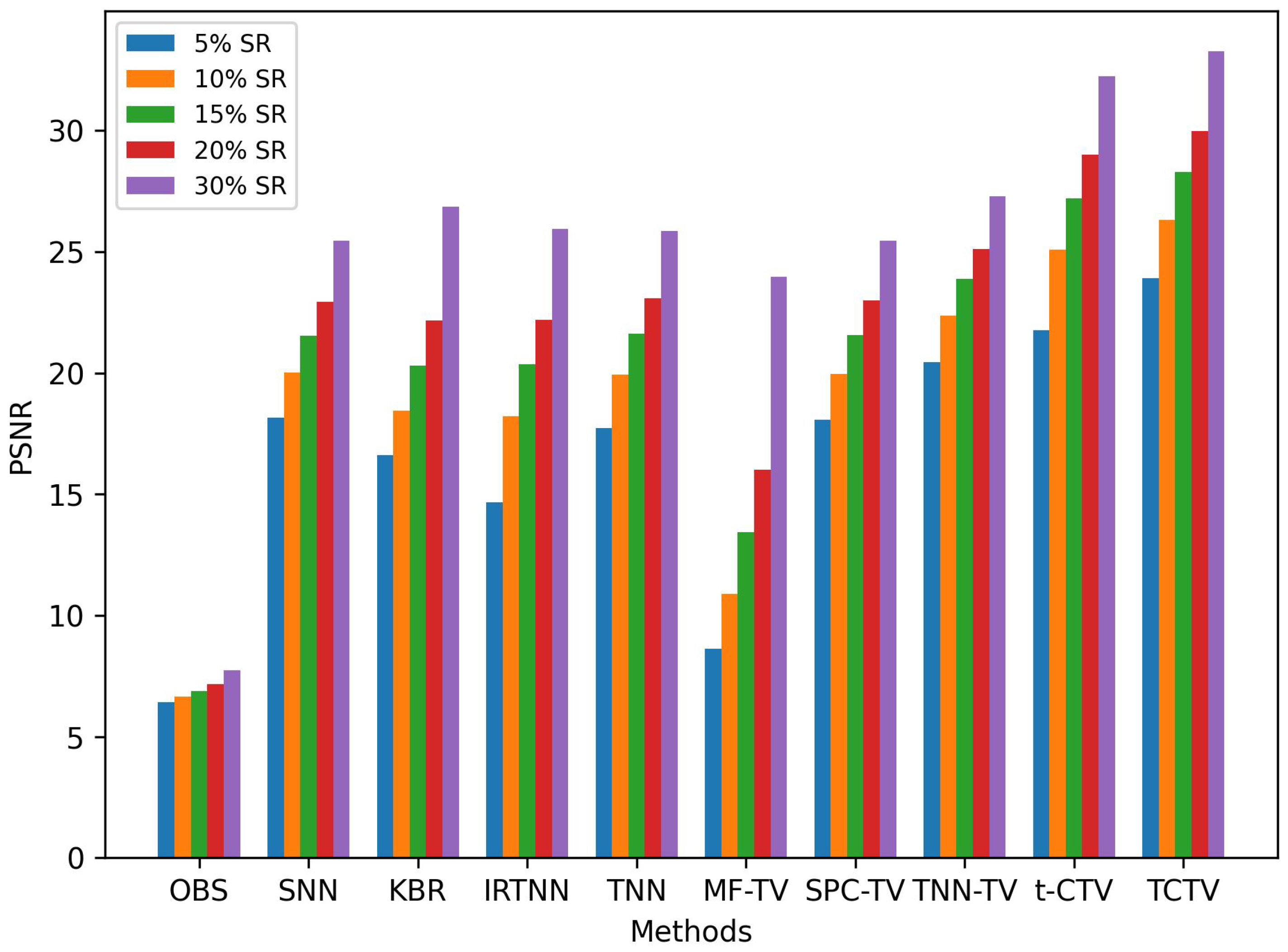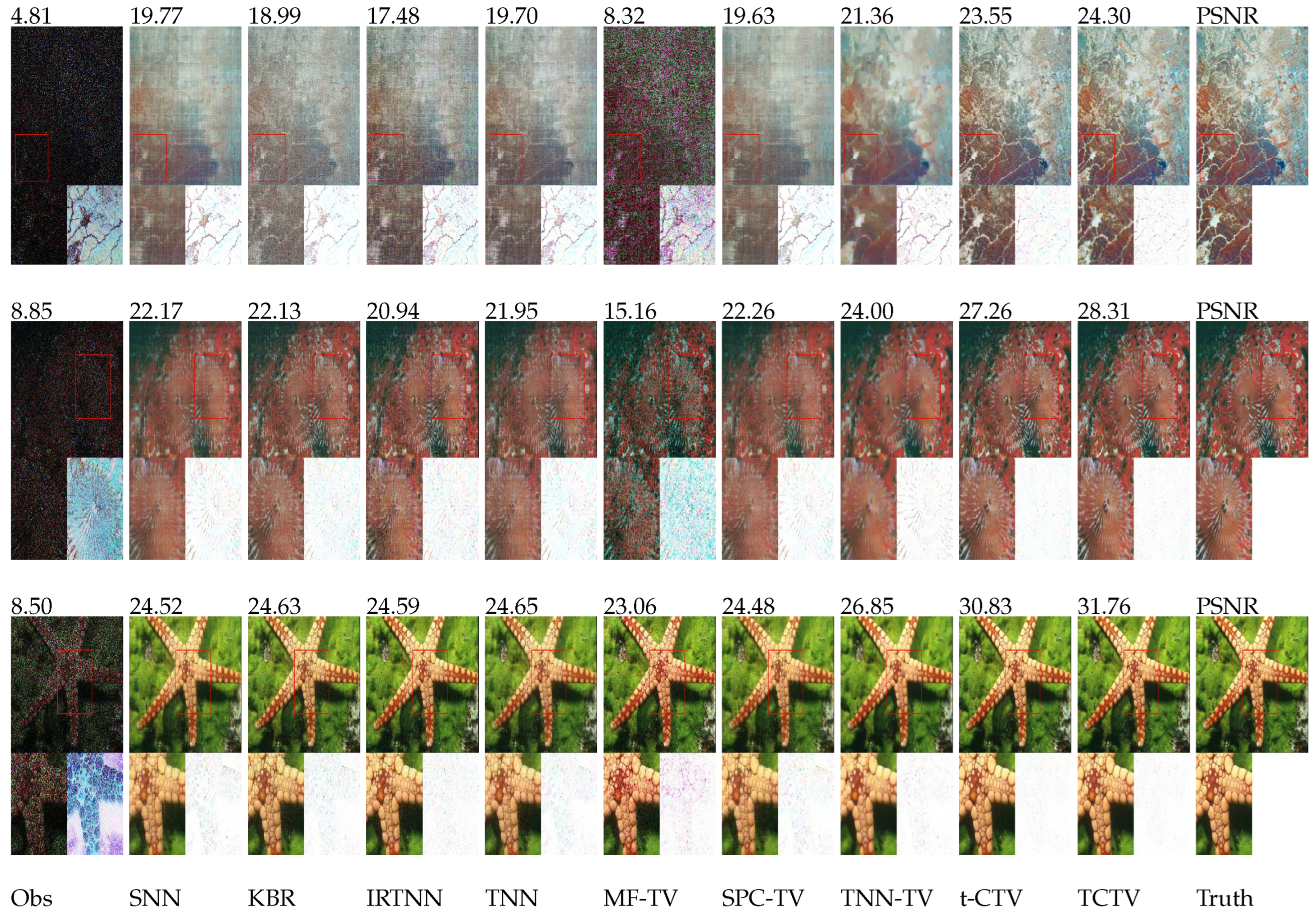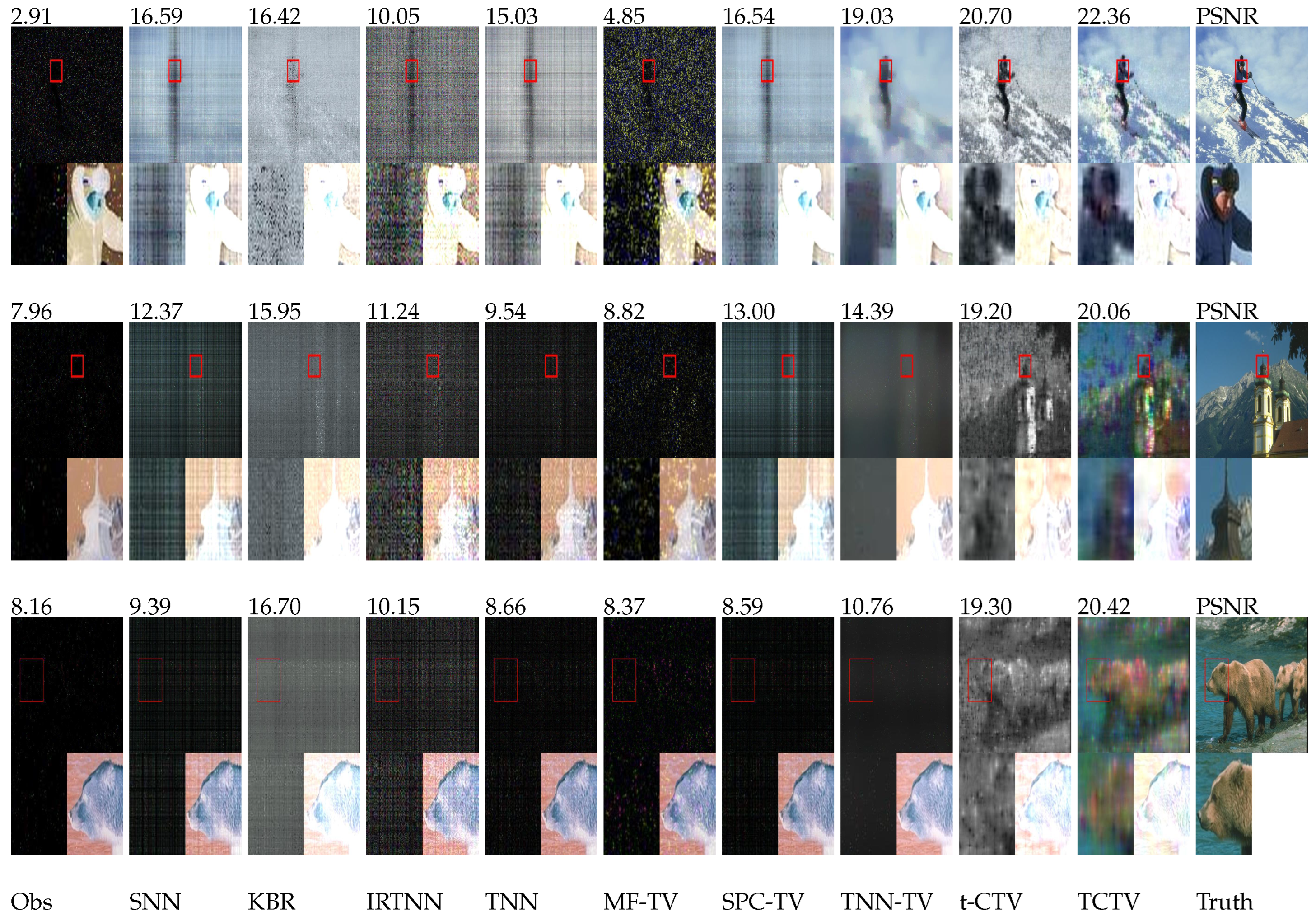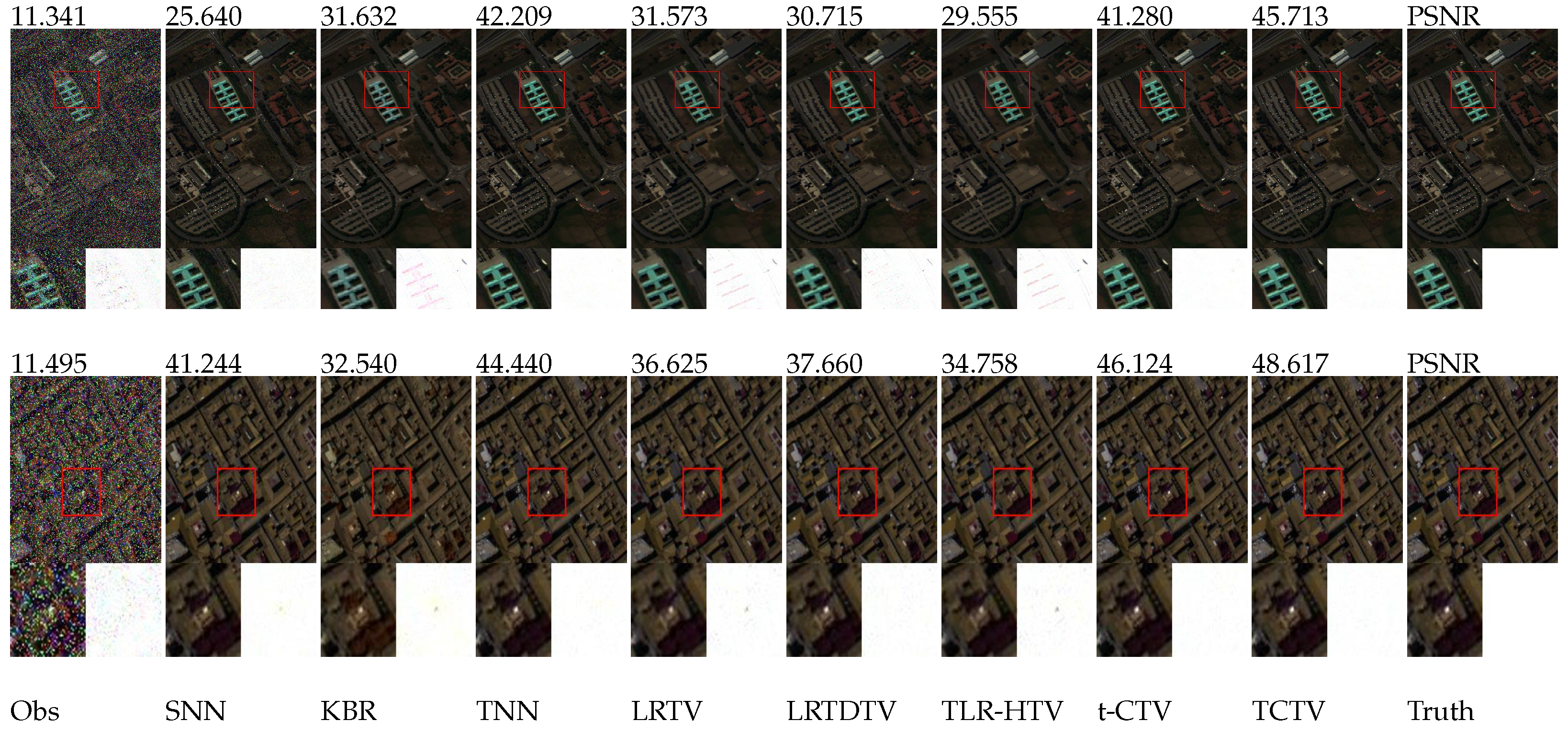1. Introduction
In the era of big data, high-order data have become ubiquitous across various scientific and engineering fields (such as signal processing [
1], computer vision [
2], machine learning [
3] and data mining [
4]). This increasing abundance of high-order data has motivated the widespread use of tensors, which serve as multidimensional extensions of vectors (first-order tensors) and matrices (second-order tensors) for modeling complex data structures. Tensor recovery is a classical inverse problem aimed at reconstructing a tensor
with certain structural priors from corrupted observations
. Due to inherent limitations in signal acquisition equipment, including sensor sensitivity and photon effects, tensor data collected often exhibit noticeable degradation, which manifests as missing values or corruptions. For observation tensors with massive amounts of information loss, this issue is often solved using tensor recovery methods based on low-rank tensor priors, leading to the formulation of tensor completion models (TC) [
5,
6]. In the case of observation tensors contaminated with substantial noise, tensor robust principal component analysis models (TRPCA) [
7,
8] are commonly employed.
In the field of low-rankness (L) priors for tensors, an unavoidable concern revolves around how to characterize the rank of tensors. Although a tensor is a higher-order extension of a matrix, the definition of tensor rank remains ambiguous, making it challenging to directly tackle the problem of tensor rank minimization. Currently, there exist numerous definitions of tensor rank based on different tensor decomposition methods, such as the CP rank [
9], Tucker rank [
10], multi-rank [
11], and tubal-rank [
12] methods, among others. However, it is NP-hard to directly solve the minimization problem for CP rank and Tucker rank. The tensor nuclear norm (TNN), widely adopted as a convex surrogate for tubal rank, is computationally efficient but fails to faithfully approximate the true tensor rank. Extensive studies have shown that the nonconvex approximation of the rank function can offer better estimation accuracy than the nuclear norm. To better approximate tensor rank, various nonconvex alternatives have been proposed, such as the
norm [
13], the
norm [
14], the
norm [
15] and so on. Researchers are committed to designing more effective regularizers to characterize low-rankness prior information about the underlying tensor, and the corresponding tensor recovery model can be constructed as follows:
where
denotes the tensor to be recovered,
denotes the observed tensor,
is the regularizer characterizing the low-rankness prior of the tensor, and
is the operator describing the degradation process. Chen et al. [
16] propose a denoising method that integrates the low-rankness prior with a Difference of Gaussian filter to enhance denoising performance. However, the effectiveness of the filter relies on appropriate parameter tuning to balance noise suppression and detail preservation.
To further enhance the accuracy of tensor restoration, researchers have focused on exploring the local features of tensors, thereby introducing the smoothness (S) characteristic. The smoothness prior describes the structural properties of a tensor, where adjacent pixels typically show similar properties or values. For
with t-SVD rank
R and L and S priors, the following inequalities are induced:
, where
denotes the gradient tensor along its
k-th mode. This implies that the L structure between the gradient tensor and the original one remains consistent, and constraining the L structure of the gradient tensor can indirectly induce the low-rank property of the original structure. The smoothness property is often characterized by the low energy of
’s gradient tensor. Since it was proven in [
17] that the difference operation changes neither low-rankness nor boundness, the L and S priors of the gradient tensor can be captured by the specific regularizer we designed.
To more effectively characterize the global low-rank properties and local smooth features of tensors, we propose a novel regularization, the Tensor-Correlated Total Variation (TCTV), based on gradient tensors and the nonconvex Geman norm. Meanwhile, based on the TCTV regularizer, we develop TC-TCTV and TRPCA-TCTV models for completion and denoising tasks and solve them using the ADMM framework. Experiments validate the outstanding performance of the proposed models in both completion and denoising tasks. The specific contributions are as follows:
We introduce a novel nonconvex regularizer termed the Tensor-Correlated Total Variation (TCTV), which is based on gradient tensors and the nonconvex Geman norm. The TCTV captures both the low-rankness and smoothness priors of the gradient tensor simultaneously, thereby alleviating the inconvenience of choosing a balancing parameter.
Building upon the TCTV regularization, we propose two novel models, namely TC-TCTV and TRPCA-TCTV. To solve these models efficiently, we design Alternating Direction Method of Multipliers (ADMM) algorithms, which can obtain closed-form solutions for each variable. Additionally, we test the sensitivity of the parameters and the convergence of the proposed algorithms.
Extensive experimental results demonstrate the robust tensor recovery capability of our model. As depicted in
Figure 1, the image recovery performance remains impressive even with a missing rate as high as 99.5%.
The remainder of this paper is organized as follows.
Section 2 introduces some notations and preliminaries under the high-order t-SVD framework. The tensor completion (TC-TCTV) model and tensor robust principal component analysis (TRPCA-TCTV) model are shown in
Section 3. In
Section 4, extensive results are presented. We draw some conclusions about our work in
Section 5.
3. Tensor Recovery with Nonconvex TCTV Norm
3.1. TCTV Norm
We propose a novel nonconvex norm, termed the TCTV, which integrates the tensor nuclear norm based on differences with the nonconvex Geman norm. This design leverages the complementary strengths of both components: the tensor nuclear norm ensures structural integrity and low-rank representation, while the Geman norm enhances accuracy in rank approximation and reduces estimation bias. By combining these advantages, the TCTV achieves superior performance in preserving fine-grained details, making it highly effective for challenging tensor recovery tasks. The definition of the TCTV is presented as follows:
For any tensor
, we define the TCTV norm based on the t-CTV norm [
17]. The main change required to convert between the two norms is to replace the convex nuclear norm with the nonconvex Geman norm.
where
represents correlated tensors of
,
denotes a prior set composed of directions along which
equips low-rankness and smoothness priors, and
m denotes the cardinality of
. Through comparative analysis in ablation experiments, we observed that the use of the Geman norm achieves favorable performance. While other nonconvex norms also demonstrated promising results, this study focuses on the Geman function as a representative case for experimental validation. The generalization of nonconvex TCTV norms will be further explored in future work to provide a more comprehensive framework.
3.2. Models
For the TC model, we suppose that
is the underlying unknown tensor with the L and S priors. The TC-TCTV model is established as follows, using the TCTV norm to characterize the joint L and S priors of
:
where
denotes the projection operator and
denotes the index set of observed entries and obey random Bernoulli sampling (
). Then, we reformulate the TC-TCTV model as follows:
where
denotes the observed tensor,
denotes the difference operator along a certain mode,
is restricted in
to compensate for the missing entries of
, and
is an indicative function that can be defined as follows:
For the TRPCA model, we assume that the underlying tensor
is corrupted by noise
. Its corruption obeys
, and
is the observation. Thus, the TRPCA-TCTV model is established as follows:
3.3. Optimization Algorithms
3.3.1. Optimization to TC-TCTV
The augmented Lagrange function of (
13) is
where
and
are Lagrange multipliers, and
is a penalty parameter. Then, (
16) can be rewritten as follows:
Step 1. Update from :
The following system is obtained by taking the derivative of (
17) with respect to
:
According to [
22], we adopt a multidimensional FFT to diagonalize the difference tensors,
, corresponding to
. Then, we can obtain the optimal solution of (
18) as follows:
where
is a tensor with all elements equal to 1, and
.
Step 2. Update
from
: For each
, we extract the part related to
:
Let
, and we consider
and
as the compositions of all face slices. Equation (
20) can then be rewritten as follows:
where
denotes the number of face slices of
. For each
, we extract the subproblem as follows:
Let
denote the singular values of
with
,
denote the gradient of
at
, and
. By setting the Lipschitz constant to 1, it is easy to prove that the gradient of
is Lipschitz-continuous. Following [
23], we consider the nonascending order of singular values and the antimonotone property of the gradient of the nonconvex Geman function to obtain two inequalities:
where
. Then, the subproblem with respect to
can be rewritten as follows through relaxation:
Based on [
23,
24], we solve (
24) through generalized-weight singular value thresholding (WSVT) [
25].
Lemma 1. For any , the auxiliary variable and . Therefore, the global optimal solution, , to (24) can be obtained as follows: Then, we can easily obtain
by concatenating
along a certain mode. The closed-form solution of (
20) is shown as follows:
Step 3. Update
from
:
Step 4. Update
and
from
: Based on the ADMM algorithm,
and
have the following update equations:
Finally, the penalty parameter,
, is updated by
, where the constant
. The entire optimization scheme for the TC-TCTV is described in Algorithm 1.
| Algorithm 1: ADMM for TC-TCTV. |
| Input: observation , priori set and transform . |
|
| Output: The optimal solution |
3.3.2. Optimization to TRPCA-TCTV
The processes for optimizing to the TRPCA-TCTV and TC-TCTV are quite similar, except that some variables are replaced in the latter. Specifically,
is replaced by sparse additive noise,
, and the observation
is modified to
. Thus, the ADMM optimization process for TRPCA-TCTV can be deduced as follows:
Here,
denotes the soft-thresholding operator. The whole optimization scheme for the TRPCA-TCTV is summarized in Algorithm 2. It begins with initializing several tensors to zero, including
,
,
, and
. Then, it enters a repeat loop where it iteratively updates these tensors and a parameter
using specific equations. The updates involve refining the estimates of
,
,
,
, and
. The parameter
is increased by a factor of
after each iteration, and the process continues until convergence is achieved. The final output is the optimal solution
, representing the refined data estimate after the iterative process has converged.
| Algorithm 2: ADMM for TRPCA-TCTV. |
| Input: observation , priori set and transform . |
Initialize Repeat Update by (32) for each Update by (33); Update and by (34), (35); Let Until converged
|
| Output: The optimal solution |
3.4. Computational Complexity Analysis
For Algorithm 1, we mainly consider the cost of calculating , , , , and in each iteration. The time complexity of computing is . The cost of calculating is . Calculating , , and have the same complexity . Therefore, the per-iteration complexity of Algorithm 1 is .
For Algorithm 2, it is easy to see that the only difference exists in calculating , which involves the soft-thresholding operator. The cost of computing is , and the total complexity is the same as in Algorithm 1.
3.5. Convergence Analysis
Since the constraints in the proposed models are separable, they can be transformed into a standard two-block ADMM by using the method given in [
26]. The convergence of Algorithms 1 and 2 can be proven by using the general conclusion given in [
26]. To provide an intuitive visualization of the error variation after each iteration, curves of the relative error against the number of iterations are plotted in
Figure 2. It is easy to see that the gap between
and
deacreases with increasing iterations. After 50 iterations, the errors gradually decrease and become closer to zero, which validates the convergence of the algorithm intuitively.
3.6. Sensitivity Analysis
Considering that
and
are two crucial parameters in Algorithms 1 and 2, we conducted a sensitivity analysis by adjusting the value of each parameter. The effects of
and
on the PSNR at various sampling rates are shown in
Figure 3. We can observe that a convincing performance in terms of the PSNR is achieved when
= 1.1 and
=
.
4. Experimental Results
In this section, we conduct numerous experiments on public datasets to evaluate the performance of the proposed models. We compare our models with different methods (
Table 1) considering L or S priors of tensors. All experiments were performed on MATLAB (R2021a); the CPU of the computer was AMD Ryzen 7 5800H with Radeon Graphics (16 CPUs), and the memory was 16 GB.
For a quantitative comparison, three picture quality indices (PQIs) were employed, including the peak signal-to-noise ratio (PSNR [
34]), structural similarity (SSIM [
35]), and feature similarity (FSIM [
36]). The larger the PSNR, SSIM, and FSIM, the better the performance of the recovery model. All the parameters used in these models were used as given in the reference papers or adjusted optimally.
Parameter setting: First, we give brief explanations of important variables in the models.
,
, and
denote the recovered tensor, gradient tensor, and noise, respectively.
is restricted in
to compensate for the missing entries of
.
and
are Lagrange multipliers. For all competing approaches, we either adopted the parameters suggested in the released code or adjusted some to obtain better results. We set
= 1.1,
=
, max(
) =
, and
= min(
, max(
)) in Algorithms 1 and 2. In (
7),
and
are set to a large value first, and then
decreases by
with
until reaching a target value of 1. Since the nonconvex norm plays an important role in two models, we conducted ablation experiments and present the results in
Table 2. In subsequent experiments, we will use only the Geman norm as an example.
4.1. Color Image Completion
In this experiment, we randomly choose 20 color images (sized
) from the BSD and USC-SIPI databases, and all original images are shown in
Figure 4. The images are corrupted with different sampling rates (from 5% to 30%). The completion results of quantitative metrics as averages are presented in
Table 3. The results show that the proposed TC-TCTV model achieved higher PSNR, SSIM, and FSIM values than the other methods. We also drew a bar chart of the PSNR values of the images recovered by the different methods (as shown in
Figure 5), which presents an intuitive comparison. Meanwhile, our method strikes a balance between the quality of the recovery results and computational efficiency. As indicated in
Table 3, the runtime of our algorithm is entirely acceptable. Due to space limitations, a partial selection of images and sampling conditions was made for an intuitive visual comparison, as shown in
Figure 6. We magnified specific local regions in the recovery image and then computed the differences between the ground truth image and the recovered images from competing methods. This approach provides a straightforward visual assessment of the restoration performance achieved by the different methods.
We further tested all the completion models on extreme conditions, when sampling rates were set to 3%, 1%, and 0.5%. Due to space limitations, the recovery results of some typical cases are given in
Table 4 and
Figure 1 and
Figure 7. In comparison, our method shows strong restoration capabilities, while other methods almost fail.
4.2. Denoising Task
In this part, we applied the TRPCA-TCTV model for the denoising task to remove noise from the observations. Due to space limitations, we only present a few examples.
Table 1 presents seven relevant methods. Likewise, we chose the parameters suggested in the release codes or tuned them finely to obtain better results.
Specifically, we chose salt and pepper noise (N) at different levels. The datasets comprise color images and hyperspectral images (hsi_PaC, PaviaU, Salinas). From the results given in
Table 5 and
Figure 8, it can be seen that our method achieves the best results when noise levels are at 20% and 40%.
5. Conclusions and Future Work
In this paper, we devised the TCTV as a regularizer to capture the low-rankness and smoothness priors of the gradient tensor. Specifically, the nuclear norm was replaced by the nonconvex Geman norm, which showed better performance in tensor rank estimation. Based on this, we constructed the TC-TCTV and TRPCA-TCTV models, which showed superior performance. Even under extreme conditions like when 99.5% of the pixel values are missing, the TC-TCTV model can still achieve impressive recovery results, while the other methods all fail.
There are still various interesting studies to carry out. We plan to develop general nonconvex TC and TRPCA models by using different nonconvex norms. It would also be meaningful to test more recovery tasks like super-resolution, flash–no flash reconstruction, and motion deblurring. We also plan to incorporate deep priors into our future work to build a more generalized model to solve various recovery tasks such as super-resolution and deblurring.

